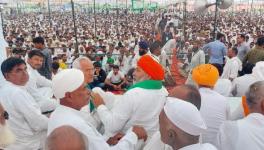Kindling the fire of agniveers: Germany’s past India’s future?

The Agnipath scheme introduced by the Union government for army recruitment on contractual basis is a catastrophe that would inevitably lead to militarisation of India. The fear looms large that after the end of contractual service these youths with arms training would be susceptible to exploitation by paramilitaries.
AT a glance, a brief article in the July 23, 2023 issue of the Tribune merits no more than a quick look from the average reader.
The article discusses the establishment of a training centre by the Adani business group, intended for training individuals to join the Indian armed forces. Notably, the conglomerate is offering this training for free.
This endeavour by Adani prompts contemplation on how close India is from the creation of its own ‘desi’ private military companies (PMC).
Just as Russia has the Wagner group and the United States has Blackwater (which is now known as Academi), India might have its own private militaries soon.
What is Agnipath?
It has been over a year since the Union cabinet approved what some are touting as the “biggest defence manpower reform” in India’s independent history— the Agnipath recruitment scheme.
On June 14, 2022, the Union defence ministry announced the details of Agnipath— a major departure from the current military recruitment scheme.
This new policy came into immediate effect and uprooted tested guidelines for recruitment of soldiers, sailors and airmen by introducing a new class of soldiers who would be known as ‘agniveers’.
Are we willing to bear the ultimate cost of the Agnipath scheme— the militarisation of our youth and potential impending violence and internal conflict in our country?
Traditionally, army recruits are required to provide at least 17 years of service before retiring with a guaranteed pension from the government.
This pension policy has remained static for decades, attracting many civilians into military service with a promise of honour and a stable income post retirement.
However, the Modi government turned this reliable career avenue with permanent tenure on its head by creating a policy of hiring army recruits on a contractual basis instead.
The tenure of these new agniveers would be four years, including a six-month training period.
Under the Agnipath scheme, an agniveer can be hired into the Indian army between the ages of 17.5 and 21, serve for four years, and then promptly exit the army and compete once more for employment in a virtually non-existent job market.
The claim is to infuse the army with youthful energy. The scheme provides attractive financial benefits, including a gross salary of ₹30,000 per month in the first year and ₹40,000 per month by the time of the fourth and final year.
In addition, agniveers will have allowances, and death and disability compensations.
Also read: Agnipath scheme: Generating more heat than light?
The pot of gold: Pension as chimeric as ever
The pot of gold at the end of the rainbow that has traditionally come hand in hand with army service is pension— a promise of stable income that provides food on the table and a roof over the head long after retirement.
Unfortunately, for agniveers, this ultimate financial benefit is available to only 25 percent of their number.
Upon completion of the four years of service, only a quarter of the agniveers will have the opportunity for extended service lasting fifteen years, which is followed by pension eligibility.
New army recruitment scheme is a “delicate needle to thread” and amounts to “playing with fire” if the government does not handle the agniveers with care.
The remaining 75 percent will be released without pension or guaranteed employment.
The Union defence ministry has assured the public that for this 75 percent of agniveers, a lump sum severance package of ₹10 lakh will be awarded, along with a bank loan to be used to find an alternative career and training in other fields.
In addition, the discharged soldiers will be given priority in hiring for paramilitaries, state police forces and governmental jobs.
However, what is left unsaid is that these agniveers may be available for recruitment into private military companies or private entities willing to pay top rupee for trained enforcers in a society riven with division.
Bajrang Dal? Other creepy crawlies?
Motivations behind the scheme
Many have speculated that there is a much stronger yet unstated undertone influencing the motivations for the Agnipath scheme: “[F]inancial exigencies arising largely due to the hefty rise of the manpower cost.”
“In 2023, funding for military pensions came to ₹1.4 trillion (US $17.2 billion), accounting for 23.3 percent of total defence spending.
“This pension burden has grown significantly since 2008, when it represented 12.6 percent of the total budget, and it has consistently been above 20 percent since 2016.
“Furthermore, India consistently spends 30 percent of the defence budget on military pay and allowances. In 2023, this area of funding came to an estimated ₹1.8 trillion (US $21.9 billion), accounting for 29.6 percent and bringing the sum of the two to over half the entire defence budget.”
Is Modi responsible?
For decades now, pensions have wavered around this percentage— amounting a burden worth about one-fifth of the defence budget every year.
Combined, pension and salary take up over 50 percent of the budget of the Union defence ministry. It is apparent that the Hindutva administration views this as wasteful expenditure.
With no duty to the army’s naam, namak aur nishan (honour, loyalty and identity), demobilised agniveers could prove to be “prospective time bombs”.
Ironically, it was Modi himself who contributed to this massive expense and burden on India’s defence budget.
Nine years ago, it was none other than Modi who ran on a campaign promise of One Rank One Pension (OROP), which promised “same pension, for same rank, for same length of service, irrespective of the date of retirement.”
Under the OROP scheme, the financial responsibilities of the Union government soared to provide pension to all its soldiers.
Reality finally caught up with Modi, as he sought ‘out-of-the-box’ solutions to rip away these empty financial promises that once got him elected.
Financially, the Agnipath scheme provides the perfect answer to Modi’s big defence problem.
The four-year tenure of 75 percent of agniveers caps the salary at ₹40,000 per month per soldier— a salary much lower in comparison to the army’s most senior soldiers.
The sum of forty thousand per month spent on each soldier is negligible compared to the cost saved by not providing post-retirement pensionary benefits.
The government has announced it will use these would-be pension funds to instead modernise the infrastructure of the army and to counter security threats to the country.
However, some claim that Modi is seeking “thriftiness at the expense of national security.”
Many sceptics are quick to point out that such a drastic upheaval of well-established and arguably effective military employment tradition is unwise if untested.
There has been “no independent study, pilot project or test run to ascertain the viability of the [Agnipath] scheme for the military.”
If the Modi administration were going to introduce such a radical departure from the norm, it should have started small and ironed out wrinkles as the months went on.
With the introduction of the Agnipath scheme came a startling lack of clarity and seeming unconcern about major red flags raised by civilians and veterans alike.
For example, what will the effect of a mere six months of training be on a currently skilled army?
How will agniveers specialise given their short tenure?
How will the imbalance of recruits from various regions and castes affect the cohesiveness of each unit?
How will discharged agniveers find employment in an unstable job market?
Are we willing to bear the ultimate cost of the Agnipath scheme— the militarisation of our youth and potential impending violence and internal conflict in our country?
On all these concerns, the silence of the Modi administration remains deafening.
Endangering job security and engendering violence
Nine years ago, when Narendra Modi sought to win his first election for Prime Minister of India, his campaign rested on a promise to resolve unemployment and poverty for the citizens of India.
Modi made bold claims to create twenty million jobs every year. Yet, by the end of his first term the problem of unemployment only grew; by 2019, unemployment in India was at a 45-year high.
Ex-soldiers could even establish ‘caste armies’ and challenge the prevailing democratic government.
Only a little over 2 percent of the workforce has secure formal jobs with access to social security— a retirement savings scheme, healthcare, maternity benefits— and written contracts of more than three years. A paltry 9 percent have formal jobs with access to at least one social security source.
Just one year later, the Covid pandemic and the lingering effects of the bizarre demonetisation devastated the informal sector and small businesses in India.
Millions of workers were in dire need of assistance from the government, yet their cries fell upon deaf ears in the Modi administration.
About 15 percent of India is undernourished. This statistic may not initially seem significant, but 15 percent of 1.34 billion people is roughly 199 million people.
Under these grim conditions, the government continued to feed the public false hope, promising creations of 1.9 million jobs in some states, while guaranteeing to provide one job to each family in other states.
Faced with nine years of lies and betrayal, the youth of India scrambles to secure futures in a country where job prospects are practically non-existent.
Though the unemployment rate over the past decade has varied by region and gender, data from the Centre for Monitoring Indian Economy shows that in 2020, only 2 percent of people aged between 15 and 19 were employed.
In the northern states, where the protests against the Agnipath scheme were rampant, these numbers are even lower.
For youth across India, securing a job in the Indian army was a major chance for perceived job security.
In rural India especially, military employment is a vital resource for young people, who undergo years of training mentally and physically in the hopes of being recruited.
These Hindi belt states, Bihar, Uttar Pradesh, Rajasthan and Haryana are impacted the most by the contractualisation of agniveers as one of the most coveted employment opportunities is now being ripped away from youth.
Also read: Uncovering the political economy of the 2023-24 budget
The Lollipop promise
The government has tried to assuage dejected youth with purported benefits available to agniveers after being discharged from service, such as a 10 percent reservation in the Central Industrial Security Force, or skills-based bachelor of arts courses in the Indira Gandhi National Open University.
Yet, given the past decade of empty promises from the government, whether these reservations and courses come to fruition remains a question. Indian youth are no stranger to betrayal at the hands of the Modi administration.
A future rife with violence?
What will happen to army aspirant agniveers after their four years of service? More bluntly put, how would you like to live in a society where young men have army training and access to weapons?
Once thrown back into a floundering economy, the future will remain uncertain for discharged agniveers, with hunger and poverty as companions once more.
Alarm bells have been raised by sociologists across the country, calling the sociological implications of the new army recruitment scheme a “delicate needle to thread”, which amount to “playing with fire” if the government does not handle the agniveers with care.
The transition from agitated, resentful ex-soldiers to brutal weapons of terrorism in the wrong hands presents a bleak picture of the future for India: a country which is treacherously sliding down the very path Germany did about nine decades ago.
Retired brigadier Rahul Bhonsle has warned that discharged agniveers are especially open for exploitation by paramilitaries in a country like India with “numerous factions, discords and insurgencies”.
The Union government, in response to concerns about youths with arms training being vulnerable to joining terrorist groups, stated that it is “an insult to the ethos and values of the Indian armed forces.”
However, retired major general Amrit Pal Singh points that in addition to India’s multitude of factions, another ingredient making discharged agniveers highly exploitable is the brief tenure of service.
Singh contends that four years is not enough time to build an allegiance with the ethos that the government claims will prevent soldiers from turning to terrorist organisations.
With no duty to the army’s naam, namak aur nishan (honour, loyalty and identity), demobilised agniveers could prove to be “prospective time bombs” with the potential to contribute to violence and lawlessness in the country.
Such fears are not unfounded. History is rife with examples of economic turbulence and agitated restlessness turning ex-soldiers to criminally lucrative opportunities.
Violent protests are already occurring over the seminal issue of unemployment. What will happen when soldiers return to the same conditions of unemployment, yet this time with professional training in violence and knowledge on how to kill?
Some senior defence and security officials predict that worse than turning to armed gangs, ex-soldiers could even establish ‘caste armies’ and challenge the prevailing democratic government.
To get a glance of our future, we need only to look back at the past. Evidence of militarisation of society resulting from prematurely decommissioned soldiers is plentiful.
Perhaps the greatest case study of all, with history’s most egregious consequences, can be seen with the Freikorps army composed of newly demobilised troops post World War I.
The transition from agitated, resentful ex-soldiers to brutal weapons appropriated by Hitler to commit genocide paints a bleak future for India: a country which is treacherously sliding down the very path Germany did about nine decades ago.
Also read: Hire and fire
A case study of the Freikorps
After the First World War, the governments of all nations were faced with the challenge of reintegrating returning soldiers. Germany in particular faced the task of absorbing freshly defeated veterans.
Rather than rising to the challenge, leadership in Germany dismissed the concerns of traumatised soldiers and offered poor support to its veterans.
As Germany continued to flounder after World War I, discontent amongst opposition parties became more pronounced.
In 1933, the National Socialist (Nazi) party seized power— aided by none other than the Freikorps. Freikorps members, hardened by years of war, were drawn to the German nationalist, hyper-masculine and anti-communist allure of the Nazi party.
Eventually, many members and ex-members of the Freikorps joined Sturmabteilung and Schutzstaffel, two groups notorious for the violence they inflicted upon civilians.
Simultaneously just one border away, Benito Mussolini was constructing his own version of the Freikorps to be deployed in Italy, called Fasci di Combattimento (fighting groups).
Historians note that Mussolini’s squads shared “the same churning contempt for civilian life, the same propensity for violence against the socialist and communist enemy, and the same determination to turn the existing political system upside-down” as their German counterparts.
Just as the Freikorps and the Fasci di Combattimento were composed of ex-front line soldiers returning from World War I, so too were the Black and Tans of Northern Ireland, formed to suppress the Irish Republican Army in Ireland.
The British Government targeted demobilised soldiers to form the Black and Tans, which went on to make a name for themselves in their brutality and murderous nature.
All three countries were linked by the rise of these fascist paramilitary groups.
History views the legacy of the Freikorps to be the militarisation of German politics. The prevailing regime in the 1930s was bolstered by ex-Freikorps members at every level of government, including Martin Bormann, head of the Nazi Party Chancellery.
The first batch of 19,000 agniveers, who commenced training on January 1, have passed out of training centres across the country. The agniveers have undergone an advance training and have joined their respective army units in early August 2023.
The training involved basic and advanced programmes that had been optimised to 24 to 31 weeks.
Earlier, training schedules in the army varied from six months to two years depending on the stream inot which a recruit was selected.
While all this is taking place, the Chinese army has adopted a recruitment policy to create a more educated and well trained army.
The Hindutva government in India is of course oblivious of the old proverb that a chain is only as strong as its weakest link.
This article has been written in collaboration with the South Asia Human Rights Documentation Centre.
Get the latest reports & analysis with people's perspective on Protests, movements & deep analytical videos, discussions of the current affairs in your Telegram app. Subscribe to NewsClick's Telegram channel & get Real-Time updates on stories, as they get published on our website.
























